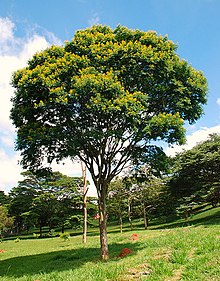Libidibia ferrea
| Brazilian ironwood | |
|---|---|
 |
|
| Scientific classification | |
| Kingdom: | Plantae |
| (unranked): | Angiosperms |
| (unranked): | Eudicots |
| (unranked): | Rosids |
| Order: | Fabales |
| Family: | Fabaceae |
| Genus: | Libidibia |
| Species: | L. ferrea |
| Binomial name | |
|
Libidibia ferrea (Mart. ex Tul.) L. P. Queiroz |
|
| Synonyms | |
|
|
Libidibia ferrea, formerly Caesalpinia ferrea, and commonly known as pau ferro, Brazilian ironwood, or leopard tree, is a tree found in Brazil and Bolivia.
Most species of Caesalpinia s.l. have poorly defined growth rings, with isolated vessels arranged in radial multiples. Pitting between vessels is alternate and covered, and fibres are generally not divided by a septum. The axial (i.e., longitudinal) parenchyma varies from a winged shape to confluent, and is irregularly storied (i.e., layered), while the rays (perpendicular to growth rings) are of variable height and generally comprise a single or double cell width.Libidibia in particular has layered longitudinal parenchyma and narrow homocellular (i.e., of uniform type) rays without crystals in the ray cells.
Its wood is often used for making fingerboards for electric basses and guitars. It has a similar feel and similar tonal attributes to rosewood, but is harder and has a slightly lighter colour. The wood may also be used for flooring, fancy furniture, and handgun grips. It is also known by the names morado, palo santo, caviuna, Brazilian ironwood, and Bolivian rosewood, though it is not actually rosewood.
In guitar making, pau ferro is not only used for fingerboards or bridges but also can be used for the back and sides of the acoustic guitar. The Brazilian guitar maker Giannini uses the wood (laminated) in many of its classical guitars. Although similar in many ways to rosewood, pau ferro has slightly different tonal qualities, with coloration from coffee brown to yellow brown and purple.
The Stevie Ray Vaughan model comes with a pau ferro fingerboard.
Pau ferro, used as a rosewood substitute, is a strong sensitizer capable of causing acute outbreaks of allergic and irritant dermatitis in workers not previously exposed to it. This, however, has not prevented furniture factories from using the product. Apparently, most workers develop tolerance to the wood. The allergen is (R)-3,4-dimethoxydalbergion, a strong skin sensitizer.
A two-week-old specimen grown from harvested seed
Bipinnately compound leaf
...
Wikipedia
